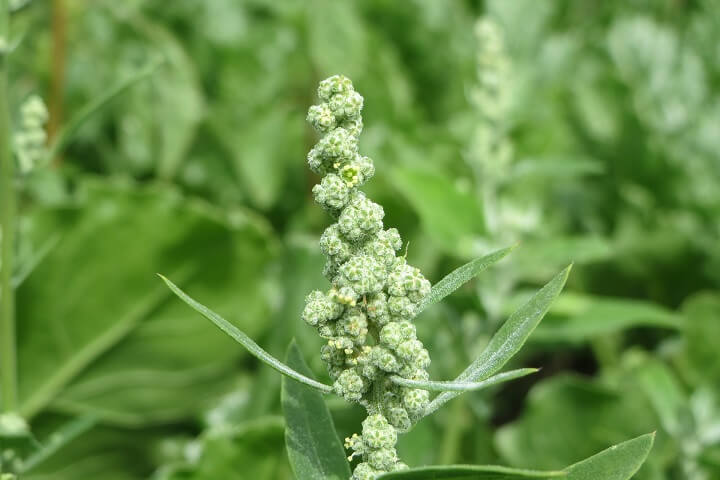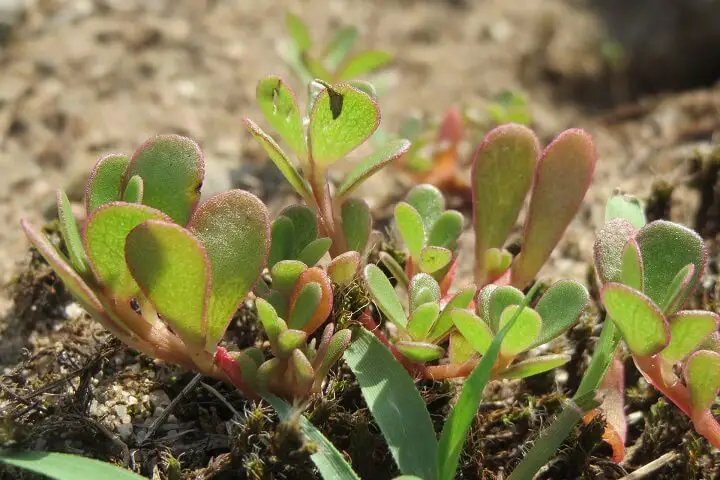Estimated reading time: 10 minutes
Pulling weeds in my garden is one of my least favorite tasks. It feels like as soon as I've conquered all of the weeds, more keep appearing. Pulling weeds is truly the never-ending task, but you don't need to feel obligated to remove all weeds. Believe it or not, there are some weeds you actually want to see in your garden.
I know, we've been conditioned to believe that all weeds are evil and must be eradicated at all costs. Those notions are false. Nowadays, we understand that weeds play a vital role in the health of the soil, and not all weeds cause havoc in your yard or garden.
Beneficial weeds can help gardeners diagnose issues within your soil. Weeds even help to repair the problems! Some are also edible, so that's not too bad.
Want to save this post for later? Click Here to Pin It on Pinterest!
The Benefits of Garden Weeds
You might be surprised to learn about the benefits of garden weeds. It helps to understand weeds to ease some of the frustration that is often felt as you pull them each week. Here are some things you should know about.
Weeds Protect The Soil
Weeds are known for being fast-growing, which is why it seems like you can never get rid of them entirely. They grow fast for a reason; they have to cover bare ground to protect it quickly.
The roots hold the soil together and stop it from eroding in the wind or rain. If you see weeds growing up rapidly, it might indicate that you need to put some layers of mulch to protect the soil.
Weeds Condition The Soil
As the roots of the weeds decay in the soil, it adds organic matter to your garden beds. It helps to condition the soil, creating channels for rain and air to move throughout the ground. These tunnels work for worms and other beneficial soil microbes as well.
Weeds Fertilize Soil
If you see weeds in your garden, it might help to accumulate vital nutrients from the subsoil, bringing the nutrients into their leaves. Later, as the leaves die back, weeds act as healing medicine for damaged topsoil, acting as a fertilizer.
Weeds Attract Beneficial Insects
Thankfully, weeds are short-lived even though they're quick to sprout. They frequently flower so that they can set seeds for the next generation. The thick foliage attracts beneficial insects that want nectar, and those insects chase away harmful insects and help to pollinate other plants.
Many Weeds are Edible
Did you know that many weeds are edible? Many gardeners toss the weeds right into the compost bins without even considering how they can be used in the kitchen.
Weeds are edible, and we've forgotten how to use weeds in recipes. Thankfully, more chefs than ever are finding brilliant ways to incorporate common weeds in recipes. You can turn common garden weeds into lunches and dinners. A few common edible weeds include salsify, purslane, watercress, and dandelions.
8 Weeds That You Actually Want in Your Garden
1. Chickweed

If chickweed pops up in your garden beds, you can be sure that you have fertile soil, which means your garden will thrive. At the same time, chickweed can indicate deficient calcium or phosphorus levels, or it might indicate an overabundance of sodium or potassium.
Chickweed shows that you should look into fertilizer options; you want to balance out these minerals. You would benefit the soil if you left them to grow and die back on its own. Another choice is to cut them back monthly and put them under mulch.
Don’t be sad when you see chickweed! You can eat chickweed leaves, stems, and flowers raw or cooked. It also has medicinal properties, and you can use this plant to create a poultice for minor wounds.
2. Clover

Do you have a rabbit problem in your garden? Clover can be your friend because it gives your friendly bunnies something else to eat other than the veggies you want to cultivate. At the same time, clover fertilizes the soil by infusing nitrogen into the ground, while it also attracts earthworms. Earthworms are the key to the fertile soil.
You might notice that clover shows up in nitrogen-lacking, dry fields, as well as lawns that have hard, clay soil. Clover attracts ladybugs, minute pirate bugs, and pollinators that are looking for nectar. At the same time, it provides shelter for parasitoid wasps, spiders, and ground beetles.
If you don’t have a rabbit issue, you can eat clover raw or cooked, or you can dry it for a cup of tea. The white clover blossoms are particularly tasty.
3. Lamb’s Quarter

This weed is known to grow in soil that has been stripped of nutrients. If you notice it in your garden, be thankful because it has a restorative effect. Lamb’s quarter spreads rapidly in an attempt to recondition the land and add nutrients back into the ground.
Lamb’s quarter accumulates nitrogen, potassium, phosphorus, calcium, and manganese while loosening the soil. If you let them grow and die back on their own, one plant sets over 75,000 seeds. Leaving the roots intact helps the plants regrow or the roots decay, enriching the soil and attracting beneficial soil organisms.
Most of the plant is edible. The shoots, leaves, and seeds are all edible. You can put lamb’s quarter in salads and soups, raw or cooked. It’s a delicious addition to your diet.
4. Pennycress

Gardeners know that you shouldn’t grow fruits or vegetables in soil with high levels of metallic minerals, such as lead, nickel, and arsenic. High levels of these minerals would kill a large variety of plants. If you notice pennycress in your garden, it can be a welcome sign because it helps to decrease the levels of metallic minerals over time.
Farmers use pennycress as a winter annual cover crop for industrial uses. It is known to increase ecosystem services without negatively influencing crop yields. Using this weed helps to prevent soil erosion and nutrient leaching while suppressing weeds and creating proper conditions for beneficial insects.
Pennycress is edible. The young leaves can be eaten raw or cooked, but make sure you harvest before the plant starts to flow. Otherwise, the leaves will taste bitter. You can add pennycress to salads and other foods, such as lasagna, in small amounts. It does have a bitter, unique flavor that not everyone likes.
5. Dandelions

Everyone knows and can identify dandelions in their yards. In the spring, these yellow blossoms dot yards and gardens all over properties. Dandelions grow well in hard-packed dirt, and their deep growing roots help to loosen up that compacted dirt. At the same time, dandelions pull nutrients into the top layer of the soil. Doing so helps the plants with shorter root systems.
Dandelions are one of the most versatile weeds. You can eat raw and cooked dandelion roots and blossoms. You can make a coffee-like drink from the roots, or soak the flowers in oil to create dandelion-infused oil. Later, this infused oil can be used to make salves and ointments.
6. Purslane

Purslane carpets garden beds and make its way into cracks in the sidewalk. It grows so quickly and densely, and it stops sunlight from reaching any seedlings below it.
Keeping purslane in your garden beds is beneficial. It acts as a living ground cover, stabilizing soil moisture while conserving water and keeping your garden healthier overall. Purslane acts like mulch but in a natural, healthier way. The deep roots reach nutrients and water that most garden plants can’t access.
At the same time, purslane is one of the weeds that enrich the top layer of soil for your other plants. Some weeds suck away the nutrients, which can damage your plants, but not purslane. It also helps to break up hardened soil, making it easier for other plants to develop a root system.
Purslane is an edible plant, and it has high levels of nutrients. You can eat it raw or cooked, and you should! This weed is high in omega-3 acids, vitamins E and C, and several minerals.
7. Mugwort

Mugwort is known as common wormwood, and it’s an invasive weed that you can find hard to eradicate. It grows almost anywhere, and it’s also huge. Mugwort is known for taking over enough veggie gardens.
Most gardeners aren't fond of it, but it has several properties that make it beneficial. This weed can absorb heavy metals, prevent erosion, and nourishes the soil that lacks nutrients. Another great benefit is that it repels insects, keeping harmful insects away from your garden.
8. Broadleaf Plantain

Plantain pops in garden beds with compacted soil. We know that it accumulates sulfur, calcium, magnesium, iron, manganese, and silicon. If you let plantain grow and die back on its own, it benefits your garden.
At the same time, it can be hard to leave broad weeds in your garden. It looks untidy! You can cut it back monthly and put them under mulch. Another choice is to lay them on top of the soil to naturally decompose. Make sure to leave the roots intact, so that the roots will regrow.
Not only does plantain add nutrients back into the ground, but it also is edible and has medicinal properties.
Final Thoughts
Weeds aren’t frustrating and useless as you thought! Keeping some of the weeds in your garden can help to break up compacted soil, bring nutrients to the top layer, and stop soil erosion. All of those lead to a fertile garden that will produce you more veggies and herbs throughout the year.
Like this post? Don't Forget to Pin It on Pinterest!













This is a wonderful post. One more weed to add is Purple Vetch. It helps the soil with Nitrogen. I kept it in my garden all summer and my plants looked like a Jurassic Garden. Thank you for your posts. I do love them so very much and they are so helpful in my journey of learning. Thank you.
I raise bees and if happen to get stung I have made a salve from plantain. It takes the sting away immediately
Gee, I forgot about that.There was another one besides plantain. Regardless, the pain is gone in an instant.